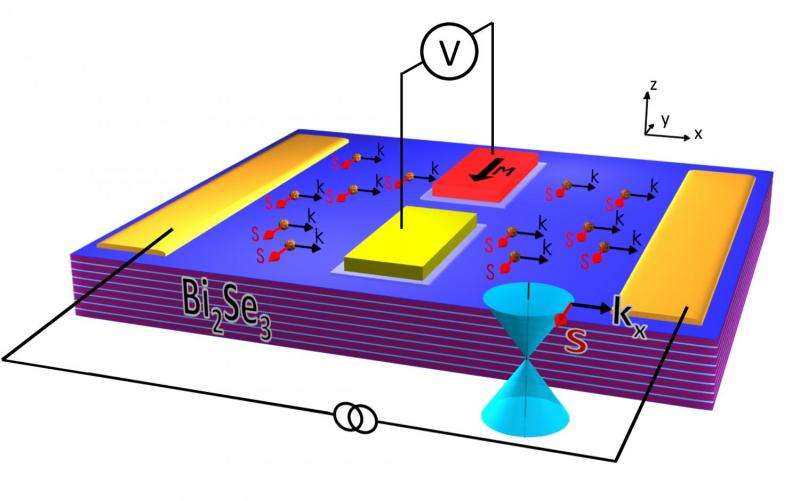NRL detects opposite spin in topological insulator surface states

Scientists at the U.S. Naval Research Laboratory (NRL) have reported the first direct comparison of the spin polarization generated in the topologically protected Dirac states of a topological insulator (TI) bismuth selenide (Bi2Se3) and the trivial 2-dimensional electron gas (2DEG) states at the surface of indium arsenide (InAs).
The NRL research team selected the two materials to clearly distinguish the polarization contributions from the linear Dirac and parabolic 2DEG surface states. Identical device structures and measurements were performed on each: Bi2Se3, a topological insulator known to have both linear Dirac and trivial 2DEG surface states; and InAs, a common semiconductor that exhibits only the trivial 2DEG surface states.
In each case, the spin polarization is spontaneously generated by an unpolarized bias current, and detected using ferromagnetic metal contacts with an oxide tunnel barrier. The researchers demonstrated that the sign of the spin polarization from these two contributions is opposite, confirming theoretical predictions and establishing InAs as a common reference sample for future experiments.
The team also developed a detailed model based on spin-dependent electrochemical potentials to explicitly derive the sign of the spin voltage expected for the TI surface states, which corroborates their experimental observations and previous theory predictions.
"Detecting this spin polarization directly as a voltage, and differentiating the contributions from these two fundamentally different systems, is key to understanding the basic properties of TI materials and interfacing them to electronic circuitry for future device applications" notes Dr. Connie Li, lead author of the study. Dr. Berend Jonker, senior scientist and principal investigator, points out "The coexistence of these 2DEG states in TI systems has generated considerable controversy in the sign of spin voltage measured. InAs provides a widely available, simply prepared reference sample which research groups around the world may use to benchmark similar polarization measurements in the future."
Topological insulators constitute a new quantum phase of matter where the bulk is nominally an insulator, but the surface layer is occupied by linearly dispersing metallic states populated by massless Dirac fermions that are topologically protected from perturbations to their environment. The existence of this class of material was predicted from the study of "topology," a branch of mathematics that describes properties that only change step-wise. The 2016 Nobel Prize in Physics was awarded to three physicists for utilizing topological concepts to study exotic phases of matter which manifest novel quantum properties that may improve future electronics, superconductors, and lead to quantum computers.
One of the most striking properties of topological insulators is that of spin-momentum locking—the spin of an electron in the TI Dirac surface state is locked at right angle to its momentum. This consequently implies that when an unpolarized charge current flows in the topologically protected surface states, a net electron spin polarization should spontaneously appear.
Electrically accessing these states is sometimes complicated by potential band bending at the TI surface that may lead to charge accumulation and formation of trivial 2DEG states with parabolic energy dispersion. These 2DEG states nest within and coexist with the linear Dirac states, and may also generate a spin polarization due to strong Rashba spin-orbit coupling—a momentum-dependent splitting of spin bands in two-dimensional condensed matter systems. Their helical spin texture, or sign of the induced polarization, however, is predicted to be opposite to that of the TI Dirac states, and with smaller magnitude.
The team's discovery is an essential step in the electrical manipulation of spins in next generation TI and spin-orbit coupling based quantum devices.
More information: C. H. Li et al. Direct comparison of current-induced spin polarization in topological insulator Bi2Se3 and InAs Rashba states, Nature Communications (2016). DOI: 10.1038/NCOMMS13518
Journal information: Nature Communications
Provided by Naval Research Laboratory



















